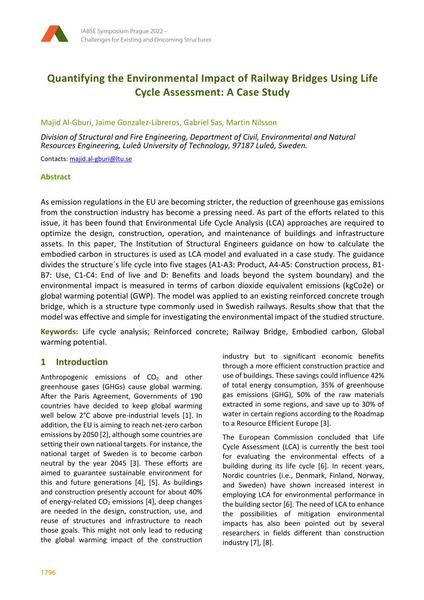Quantifying the Environmental Impact of Railway Bridges Using Life Cycle Assessment: A Case Study

|
|
|||||||||||
Détails bibliographiques
| Auteur(s): |
Majid Al‐Gburi
(Division of Structural and Fire Engineering, Department of Civil, Environmental and Natural Resources Engineering, Luleå University of Technology, 97187 Luleå, Sweden.)
Jaime Gonzalez‐Libreros (Division of Structural and Fire Engineering, Department of Civil, Environmental and Natural Resources Engineering, Luleå University of Technology, 97187 Luleå, Sweden.) Gabriel Sas (Division of Structural and Fire Engineering, Department of Civil, Environmental and Natural Resources Engineering, Luleå University of Technology, 97187 Luleå, Sweden.) Martin Nilsson (Division of Structural and Fire Engineering, Department of Civil, Environmental and Natural Resources Engineering, Luleå University of Technology, 97187 Luleå, Sweden.) |
||||
|---|---|---|---|---|---|
| Médium: | papier de conférence | ||||
| Langue(s): | anglais | ||||
| Conférence: | IABSE Symposium: Challenges for Existing and Oncoming Structures, Prague, Czech Republic, 25-27 May 2022 | ||||
| Publié dans: | IABSE Symposium Prague 2022 | ||||
|
|||||
| Page(s): | 1796-1803 | ||||
| Nombre total de pages (du PDF): | 8 | ||||
| DOI: | 10.2749/prague.2022.1796 | ||||
| Abstrait: |
As emission regulations in the EU are becoming stricter, the reduction of greenhouse gas emissions from the construction industry has become a pressing need. As part of the efforts related to this issue, it has been found that Environmental Life Cycle Analysis (LCA) approaches are required to optimize the design, construction, operation, and maintenance of buildings and infrastructure assets. In this paper, The Institution of Structural Engineers guidance on how to calculate the embodied carbon in structures is used as LCA model and evaluated in a case study. The guidance divides the structure´s life cycle into five stages (A1‐A3: Product, A4‐A5: Construction process, B1‐ B7: Use, C1‐C4: End of live and D: Benefits and loads beyond the system boundary) and the environmental impact is measured in terms of carbon dioxide equivalent emissions (kgCo2e) or global warming potential (GWP). The model was applied to an existing reinforced concrete trough bridge, which is a structure type commonly used in Swedish railways. Results show that that the model was effective and simple for investigating the environmental impact of the studied structure. |
||||
| Copyright: | © 2022 International Association for Bridge and Structural Engineering (IABSE) | ||||
| License: | Cette oeuvre ne peut être utilisée sans la permission de l'auteur ou détenteur des droits. |
||||

